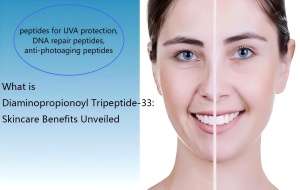What is Diaminopropionoyl Tripeptide-33: Skincare Benefits Unveiled

Diaminopropionoyl tripeptide-33 is a cutting-edge bioactive peptide transforming skincare. Known for its anti-aging and photoprotective properties, it shields skin cells from UVA-induced DNA damage while promoting repair. This innovative ingredient, often found in advanced cosmetic formulations, offers a scientific approach to combating premature aging and environmental stress. Let’s explore its origins, functions, and benefits in modern skincare.
Origins and Composition of Diaminopropionoyl Tripeptide-33
This peptide, also known as Preventhelia, is synthetically produced through the reaction of 2,3-diaminopropionic acid and tripeptide-33. Its molecular formula, C17H27N7O5, reflects a tetrapeptide structure designed for stability and efficacy in skincare applications.
Chemical Synthesis Process
The synthesis involves combining 2,3-diaminopropionic acid with tripeptide-33 under controlled conditions to form a bioactive compound. This process ensures the peptide’s purity and functionality, making it suitable for cosmetic use. Manufacturers like Chengdu Youngshe Chemical Co. specialize in producing high-quality peptides for such purposes.
Role of Peptides in Skincare
Peptides are short chains of amino acids that act as signaling molecules in the skin. They stimulate cellular processes like collagen production and repair, which are crucial for maintaining youthful skin. Diaminopropionoyl tripeptide-33 stands out due to its targeted action against UV damage.
Key Functions in Skincare
Diaminopropionoyl tripeptide-33 excels in protecting and repairing skin at a cellular level. Its primary role is to combat photoaging by preventing damage from ultraviolet radiation and enhancing the skin’s natural repair mechanisms.
Protection Against UVA-Induced Damage
UVA rays penetrate deep into the skin, causing DNA damage and protein carbonylation, which accelerate aging. This peptide inhibits the formation of reactive carbon species (RCS), reducing oxidative stress and protecting keratinocytes and fibroblasts, the cells responsible for skin structure and elasticity.
DNA Repair Enhancement
Beyond prevention, the peptide boosts the skin’s DNA repair capacity. By neutralizing harmful compounds like 4-HNE (4-hydroxynonenal), which impairs DNA repair, it helps maintain genomic integrity, reducing the risk of long-term damage and premature aging.
Anti-Wrinkle and Anti-Photoaging Benefits
By preserving skin cell health, diaminopropionoyl tripeptide-33 minimizes the appearance of fine lines and wrinkles. Its photoprotective effects also help maintain skin firmness and elasticity, countering the sagging caused by environmental stressors.
Applications in Cosmetic Products
This peptide is a star ingredient in anti-aging serums, creams, and sunscreens. Its versatility allows it to be incorporated into various formulations, enhancing their efficacy against environmental damage.
Popular Product Types
You’ll find diaminopropionoyl tripeptide-33 in high-end skincare lines, often marketed as Preventhelia. It’s commonly used in day creams with SPF, night serums, and targeted treatments for mature skin. Brands leverage its science-backed benefits to appeal to consumers seeking advanced skincare solutions.
Combining with Other Ingredients
The peptide pairs well with vitamins like B3, B5, and E, as well as other peptides, to create synergistic effects. These combinations amplify skin regeneration, hydration, and barrier strength, making products more effective for comprehensive anti-aging care.
Safety and Efficacy
Diaminopropionoyl tripeptide-33 is considered safe for cosmetic use, with low risks of irritation or toxicity. Its efficacy is supported by scientific studies, though more research is needed to fully understand its long-term impact.
Safety Profile
According to the Environmental Working Group (EWG), this ingredient scores low for concerns like cancer, allergies, and reproductive toxicity. It’s not on restricted or unacceptable lists, making it a reliable choice for most skin types. However, patch testing is recommended for sensitive skin.
Scientific Backing
Studies, such as those referenced by MedChemExpress, confirm its role in protecting skin cells from UVA damage. Research also highlights its ability to reduce protein carbonylation, a key factor in photoaging. While promising, ongoing studies aim to explore its broader applications.
How to Incorporate It into Your Skincare Routine
Adding diaminopropionoyl tripeptide-33 to your regimen can elevate your anti-aging efforts. Here’s how to use it effectively for maximum benefits.
Choosing the Right Product
Look for serums or creams listing diaminopropionoyl tripeptide-33 or Preventhelia in the ingredients. Opt for products with complementary actives like hyaluronic acid or niacinamide to enhance results. Check for reputable brands with transparent labeling.
Application Tips
Apply peptide-based products after cleansing and toning but before heavier moisturizers or sunscreens. Use morning and night for consistent protection and repair. A pea-sized amount is typically enough for the face and neck.
Consistency and Expectations
Results, such as smoother skin and reduced fine lines, may take 4–8 weeks with regular use. Pairing with broad-spectrum sunscreen amplifies its photoprotective benefits, ensuring long-term skin health.
Future Potential and Innovations
As peptide technology advances, diaminopropionoyl tripeptide-33 is poised to play a larger role in personalized skincare. Its ability to target specific aging mechanisms makes it a candidate for next-generation formulations.
Emerging Research
Ongoing studies are investigating its potential in combination therapies and its effects on other skin concerns, like hyperpigmentation or inflammation. Researchers are also exploring delivery systems, such as liposomes, to enhance penetration and efficacy.
Market Trends
The demand for science-backed ingredients is driving innovation in peptide-based skincare. Consumers increasingly seek products with proven actives, positioning diaminopropionoyl tripeptide-33 as a staple in premium anti-aging lines.


